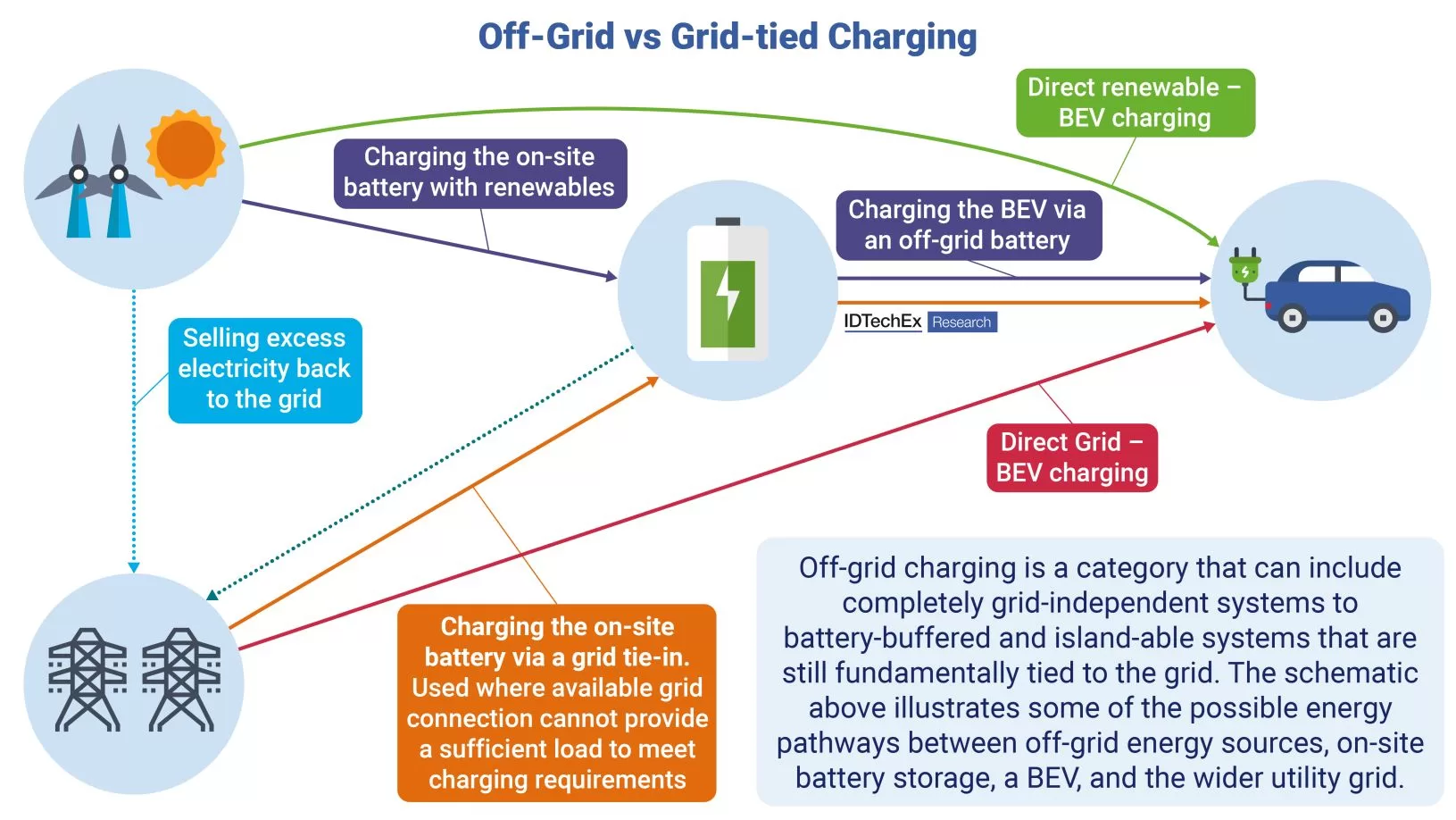
Author: Mika Takahashi, Technology Analyst at IDTechEx
Electric vehicles are no longer a niche oddity but fully mainstream, with many automotive manufacturers announcing targets to phase out ICE construction in favor of BEVs (battery electric vehicles). Passenger cars are not the only sectors where electrification is taking off. Medium and heavy-duty haulage, construction, agriculture, and mining are all under pressure to reduce transport-related greenhouse gas emissions (GHG), and going electric is an increasingly attractive solution. However, this rapidly accelerating uptake poses an enormous challenge for aging utility grids. These electrical distribution and transmission networks were never designed to carry the estimated 22,000TWh (22 billion kWh) that the transportation sector currently gets from fossil fuels. The problem is even more acute for locations where there is no existing grid infrastructure. Constructing new cabling and transformers is not only expensive but incredibly time-consuming. The question then arises: how will EVs be charged when grid infrastructure is lacking or simply non-existent?
Off-grid charging to fuel vehicles constrained by access and supply |
|
|
|
|
||
 Overview of the different energy pathways for off-grid/grid-tied and a hybrid grid solution. Source: IDTechEx |
||
|
One of the key emerging solutions is off-grid EV charging. IDTechEx’s new report, “Off-Grid Charging For Electric Vehicles 2024-2034: Technologies, Benchmarking, Players and Forecasts”, provides clarity in this emerging and rapidly growing space. These technologies connect an EV directly to an energy source (via battery storage) bypassing the electricity grid. They may be integrated such that trickle charging from the grid or selling excess electricity back to the mains supply is possible, but broadly speaking, these charging methods can operate fully off-grid.
Solar canopies – photovoltaics to motion
IDTechEx identifies solar canopies as an early market leader in off-grid EV charging, particularly in the USA. A relatively simple concept consisting of an overhead photovoltaic canopy that shades the car and provides charge to the battery, these have the additional benefit of being free to run.
However, key technical limits are expected to constrain the growth and adoption of these devices to specific regions and use cases. The power per area productivity of solar panels is fairly low, typically around 300W per square meter. This limits the power generation and hence charging rates of these canopies to low AC levels, which, while may be suitable for top-up charge in consistent sunlight, are unlikely to be competitive in the increasingly high-powered fast charging market. They are also unable to produce power at night or in inclement weather and have a hefty price tag, especially considering the charging rates.
Through primary interviews and technical analysis, IDTechEx appraises solar canopies and the various key players in this burgeoning industry. This report also contains an analysis of the various technical advancements in photovoltaics, and supply chain assessments.
Hydrogen generators – fuel cell technology for BEVs?
Fuel cell electric vehicles sales trail battery electric vehicles despite continued and sustained interest from OEMs. One of the major problems is seen as high upfront costs and difficulty in sourcing hydrogen. The emergence of BEVs, in some senses FCEVs' main competitor, may ironically provide a lease of life to the FC in the form of temporary distributed generation. IDTechEx research reveals that there is a small but actively growing market for fuel cell generators, where on-site stored hydrogen can be converted to electricity when required. Many of these have been designed for distributed generation; however, there is an emergence of these hydrogen fuel cell generators to charge EVs.
Hydrogen offers a benefit over other renewable sources as it can be used to produce electricity at any time of day, regardless of the weather, as long as there is a supply of hydrogen. This is in stark contrast to renewables, which are often highly variable and intermittent. Despite these benefits, there are significant challenges involved in sourcing cheap green hydrogen. IDTechEx analysis also shows that the type of hydrogen used significantly impacts the overall CO2 emissions, with certain colors of hydrogen potentially being more environmentally damaging than diesel generators. In spite of these challenges, IDTechEx believes that hydrogen-powered EV charging will have strong growth over the coming decade, especially in sectors that require higher charging and are most difficult to connect to the utility grid. Construction and public highway fast charging are also highlighted in the report, with the overall market value expected to reach US$14 billion by 2034.
With a booming EV market, the grid will be increasingly strained, leading to a growing demand for off-grid solutions in some situations.
IDTechEx answers key questions and provides in-depth research into this emerging and increasingly relevant field, such as:
Market forecasts, player profiles, benchmarking, and comprehensive company lists are all provided, making this an essential reading for anyone looking to gain in-depth industry knowledge.
To find out more about the IDTechEx report “Off-Grid Charging For Electric Vehicles 2024-2034: Technologies, Benchmarking, Players and Forecasts”, including downloadable sample pages, please visit www.IDTechEx.com/OffGridEV.
For the full portfolio of electric vehicle market research from IDTechEx, please see www.IDTechEx.com/Research/EV.
Upcoming free-to-attend webinar Hydrogen and Solar Charged Electric Vehicles: Navigating the EV Transition with Constrained Electrical Grids
Mika Takahashi, Technology Analyst at IDTechEx and author of this article, will be presenting a free-to-attend webinar on the topic on Thursday 25 April 2024 – Hydrogen and Solar Charged Electric Vehicles: Navigating the EV Transition with Constrained Electrical Grids.
In this webinar, IDTechEx will present some technical and commercial considerations around two of the key emerging options: hydrogen generator BEV charging and solar canopies. IDTechEx forecasts substantial growth in the market, with a hardware value expected to reach US$16 billion by 2034. This webinar will address the increasing need for off-grid charging as well as the key aspects of the solutions on offer.
Key takeaways from this webinar include:
Please click here to check timings and register for your specific time zone.
If you are unable to make the date, please register anyway to receive the links to the on-demand recording (available for a limited time) and webinar slides as soon as they are available. |


